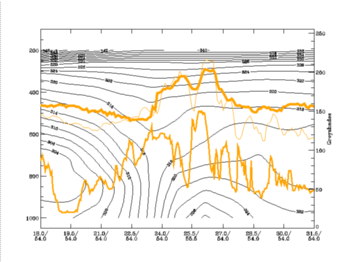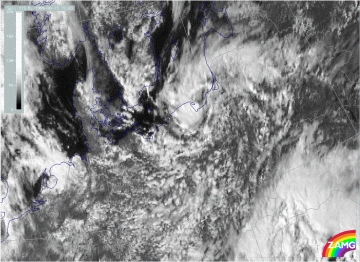Meteorological Physical Background
As already mentioned in the first sub-chapter (see Cloud structure in satellite image ) there are two synoptic-scale environments which lead to the development of convective Convergence Lines discussed in this chapter: the leading area of frontal cloud bands and the cold air region behind frontal cloud bands. Little relationship to parameters typical for these regions and contributing to upward motion such as temperature advection (warm advection) or vorticity advection (positive vorticity advection) could be found. As these convective lines can be regarded as small scale phenomena Local Area Models (LAM) have to be studied for a deeper explanation.
Likewise, for the orographically driven convective Convergence Lines (see Orographically Induced Convergence Lines ) cloudiness is produced by upward motion due to low level convergence which is the result of different processes described below. These Convergence Lines also show a life cycle during the day time dependant on solar radiation with a maximum of convection in the early afternoon.
The pre-frontal Convergence Lines
Pre-frontal convective lines are influenced by an approaching frontal system as well as the diurnal variation of solar radiation. Consequently, the synoptic situation is changing during day.
|
09 June 1999/06.00 UTC - Meteosat VIS image
|
09 June 1999/12.00 UTC - Meteosat VIS image
|
|
09 June 1999/16.00 UTC - Meteosat VIS image
|
|
The sequence from 06 to 16 UTC clearly shows the convective developments along the Convergence Line. The very intensive developments are shown by a satellite image sequence. Two influences can be noticed:
- The development related to the solar radiation and heating of the land
- The approach of the upper level cloudiness (better seen in the IR images) which might be indicative of the cold air at upper levels; at the same time low level clouds (better seen in the VIS image) remain to the rear of the Convergence Line and slowly dissolve.
|
09 June 1999/06.00 UTC - Meteosat IR image; 09.00 - 16.00 UTC hourly image loop
|
09 June 1999/06.00 UTC - Meteosat VIS image; 09.00 - 16.00 UTC hourly image loop
|
The existence of colder and drier air crossing at higher levels can be checked with help of relative streams.
The vertical cross section shows two peaks in the pixel values. One at 54N/23E is the frontal cloud band. The other at 54N/26E belongs to the convective Convergence Line. The isentropic surface of 318K lies above both the frontal and the unstable layer.
|
09 July 1999/12 UTC - Vertical cross section; black: isentropes (ThetaE), orange thin: IR pixel values, orange thick: VIS pixel values
|
09 June 1999/12.00 UTC - Meteosat VIS image; magenta: relative streams 318K, yellow: isobars 318K; position of vertical cross
section indicated
|
There is a relative stream from the cold air behind the frontal zone crossing the Cold Front band. This leads to an unstable stratification of the troposphere and goes hand in hand with the intensification of the convective cells. The mechanism for the developing of convective cloudiness described in the chapter describing MCSs (see Cb and MCS ) is also evident in this conceptual model.
But this is only an insight into the situation at the synoptic scale. The results cannot explain the band form of the pre-frontal Convergence Line. For this LAM models (e.g. Aladin) have to be studied. Small scale wind fields clearly show a confluence zone in front of the main frontal cloud band which results in a small scale convergence zone.
|
09 June 1999/12.00 UTC - Meteosat VIS image; green: wind vectors 925 hPa
|
09 June 1999/12.00 UTC - Meteosat VIS image; cyan solid: convergence 925 hPa, cyan dashed: divergence 925 hPa
|
Such a situation is common knowledge of forecasters. The main reason is differential heating. It is similar to the process mentioned for the development of Cb Clusters in warm air (see Cumulonimbus Clusters In Warm Air ). Nevertheless there are some open questions regarding the location of the development of the Convergence Line. In about half of the cases the line appears at the eastern boundary of the bright WV band. This indicates different air masses above resulting in different heating of the ground.
Post-frontal convergence bands
According to literature, convergence bands in the cold air are caused by instability and solar radiation and there is a life cycle during the day. However, the sequence shown below shows a decrease of convective cloudiness already in the early afternoon.
One might conclude that there are no additional factors that increase the convergence such as the flow of drier and cooler air at higher levels, typical for pre-frontal Convergence Lines. The post-frontal cloud bands already lie within dry and cold air which restricts the vertical extent of the convective lines.
|
13 August 1999/09.00 UTC - Meteosat VIS image
|
13 August 1999/12.00 UTC - Meteosat VIS image
|
|
13 August 1999/15.00 UTC - Meteosat VIS image
|
13 August 1999/10.00 UTC - Meteosat VIS image; 10.00 - 15.00 UTC half-hourly image loop
|












